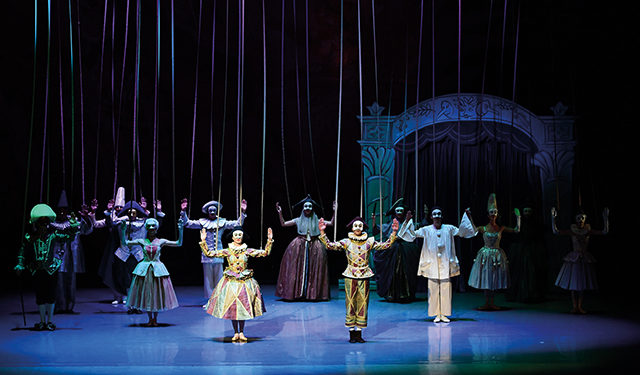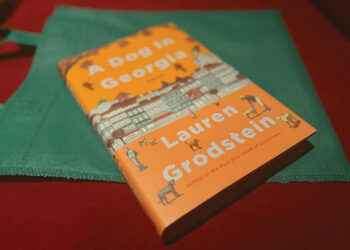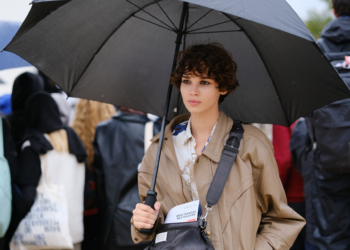Having been ashamedly lax in my attendance of the Tbilisi Ballet of late, largely due to pandemic concerns, I decided to dive back in and drag my kids from their beloved screens to enjoy the fun and cultural experience of Pinocchio.
The Opera House, following guidelines, had us spaced out on alternating seats. Another big change saw the front half of the auditorium hosting the string section of the Theater Orchestra in place of the front row seats, while the wind and percussion were in their customary place below the stage. Although a tragedy in terms of necessarily lost ticket sales, the fact of having the orchestra, and conductor Revaz Takidze, so close to us, and the instruments almost within arms’ reach, gave us a much more intimate experience overall, and it gave me a prime opportunity to give my kids some fun facts about the instruments prior to the show. Then the curtain lifted and the orchestra put us promptly on the rollercoaster of emotion and drama that comes with the ebb and flow of Ottorino Respighi’s score.
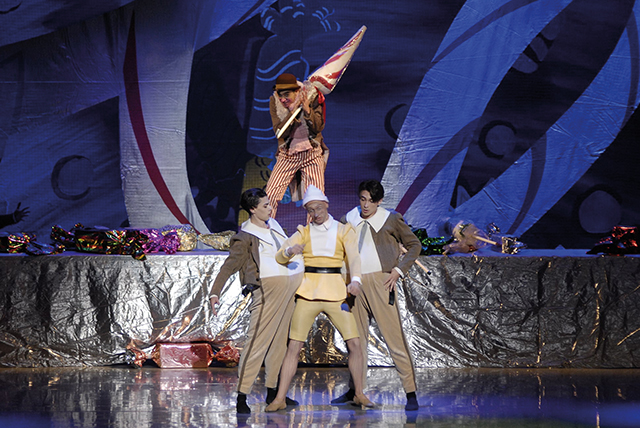
First on stage was a clearly poor and lonely Geppetto (Andrii Havryliuk), who was gifted a log to carve by the townsfolk. Back home, in front of a fire, Pinocchio soon emerged to demand to be able to go to school with the other children. Left alone while Geppetto went to buy him clothes, Pinocchio (played by Papuna Kapanadze) began to delight us with his antics as he discovered his limbs, and then burnt his feet in the fire! We were quickly to discover his naughty streak, with school books sold in temptation of a trip to the puppet theater, at the invitation of Fox (Diego Buttiglione) and Cat (Ruika Yokoyama), and despite severe warnings from the good conscience of Cricket (Nutsa Chekurashvili).
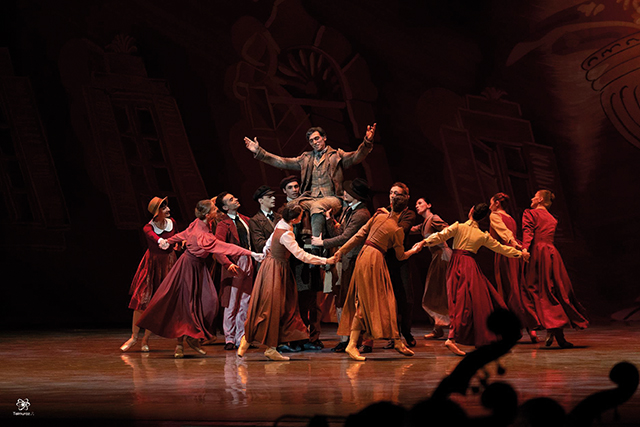
At this point, my three were delighted to see Pinocchio join us in the audience and take a seat nearby to watch the incredible dance of the puppets. The scene left me in true awe- each of the dancers had strings attached and running to the rafters, and yet their carefully choreographed moves led to not a single tangle!
I had spoken to costume designer Jerome Kaplan, first time in Georgia, and choreographer Par Isberg before the show. I asked Jerome what his inspiration had been for the dancers’ clothing.
“The inspiration for the costumes came from Italy at the end of the 19th century, and, considering Respighi was being used, I thought it was important to keep the costumes close to the Italian influence and music,” he told me. “I did what I always do to prepare for design- I collected various illustrations of Pinocchio to try to find the alphabet of the ballet. I select what I like and summarize what is the best, the most beautiful and most interesting. Because the focus is Italian, I decided not to use any influences from the Georgian style, but, normally, I would look for the mood, color and shape of the country in which I am in and apply it to the project I’m working on. I will be back to Georgia in future, though. So let’s see.”
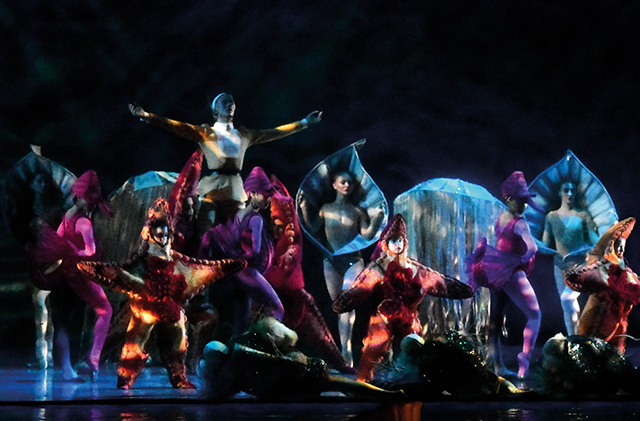
I then asked Par Isberg how he had managed to find balance in bringing a children’s tale to the stage for a mixed audience of adults and young.
“I’ve done a lot of family productions, and I don’t believe you have to go down to a childish level to convey a children’s story. As children, we always look for more than just the magic, and that feeling is what I wanted to recreate. That said, every artist needs a sense of freedom and to be able to play with their inner child. This is my first time working with the Tbilisi dancers, but dance is an international language, so other than the pandemic restrictions, there were no specific challenges here, and I’m happy with the results.”
And he had every right to be. On returning from the intermission, having seen Pinocchio head off to explore yet another tempting offer from Fox and Cat (leaving Ms Cricket shaking her head in despair), the children in the audience were enlivened by a scene of school children and Pinocchio gorging themselves on giant candies. Enormous striped lollipops were thrown and danced around hither and tither as wide eyes watched and stomachs rumbled (I already knew I’d be stopping at the candy shop on the way home that night!); then more candies floated down onto the stage, met by gasps and parents being asked, “Can I go and get one?”
“Mummy, their tummies are getting bigger!” my 7-year-old then whispered in my ear as several dancers’ belts popped open. And indeed they were. While the dancers were as nimble as ever in their leaps and bounds, their girth was definitely growing. And at last the dancers came to rest, and awoke the next morning, as those who know the tale well can predict- as donkeys!
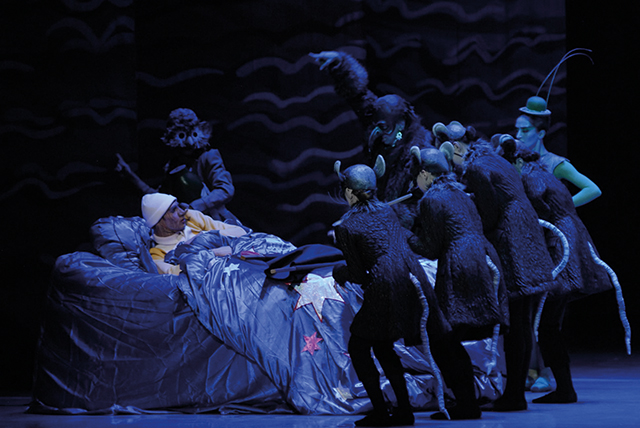
Another exciting scene began with ribbons opened by dancers to represent a circus tent, under which acrobats rolled and tumbled, and Pinocchio-the-donkey was whipped into submission to perform. On hurting his leg, he was left to the care of Cricket and the spectacular and delicate Blue Fairy (Ekaterine Surmava). At this point, with no words spoken and only dance to convey, we saw Pinocchio’s naughtiness get the better of him, and his incredible nose began to grow. Only with repentance and the help of the Blue Fairy was he able to return to health and go on a search for Geppetto…and this led to another “wow” from the set designers (led by Bo-Ruben Hedwell): lengths of blue tulle and silk took us to the sea, dancers representing waves whirled around and crashed against poor Pinocchio as he swam. Pinocchio sank and we were taken down with him into a magical, colorful world of jellyfish, clams, and tropical fish, with turtles and starfish played by the youngest members of the State Ballet Company. Back on the surface, a giant fish arose from those waves, his mouth open, teeth bared. And in his mouth was Geppetto. With father and son reunited and Pinocchio truly sorry for his wrongs, the Blue Fairy granted him the right to live as a real boy.
My kids were happy; my eldest re-inspired to take up ballet again, my son exclaiming at the big lollipops and the giant fish; my middle daughter wowed by how high the ballet dancers had jumped. Pinocchio, as performed by the Tbilisi State Ballet, had achieved its goal to entertain equally both the youngest and oldest in the audience, bringing alive a childhood tale and waking us up from a too-long slumber without the delights of the State Ballet of Georgia. And I’m not the only one to think so.
“On behalf of Friends of the Georgian Ballet, I would like to express our gratitude to Nina Ananiashvili [Director of the Ballet Company], and the dancers, who are so talented and work so hard to give us these incredible performances, which are often like little pieces of Europe,” said Friends of the Georgian Ballet Board Member Gilles Carasso following the premiere. “That gratitude is deeper this year. The pandemic, while difficult for all of us, was a catastrophe for the performing arts and artists- everything stopped. No performances, no money coming in, no chance to work. But they never gave up. When they couldn’t perform in the theater, they danced Don Quixote for us in the car park. And it was incredible. Once back in their premises, they began moving step by step forwards, and I was again amazed. And when you think of the conditions in which Pinocchio was prepared- masks, distancing, etc., the set design and music, all together it was an incredible success,” he said.
The Friends of the Georgian Ballet is a non-profit organization that was founded in 2006. It aims to support the initiatives of the State Ballet of Georgia under the artistic directorship of prima ballerina Nina Ananiashvili, and so facilitate the process of development of the Georgian ballet.
The membership fee of FGB serves to provide funding for scholarships for promising young ballet students at the V. Chabukiani Choreographic School, and participation by specially selected members of the Ballet Company in prestigious ballet competitions and master classes held around the world.
Since 2007, the FGB and the Prima Ballerina have awarded annual scholarships to selected students of the Ballet School based on talent and/or social need, while also supporting the participation of students and company dancers in international competitions and masterclasses.
New members are always welcome.
The world premiere of Pinocchio took place in Hong Kong in 2015.
By Katie Ruth Davies

